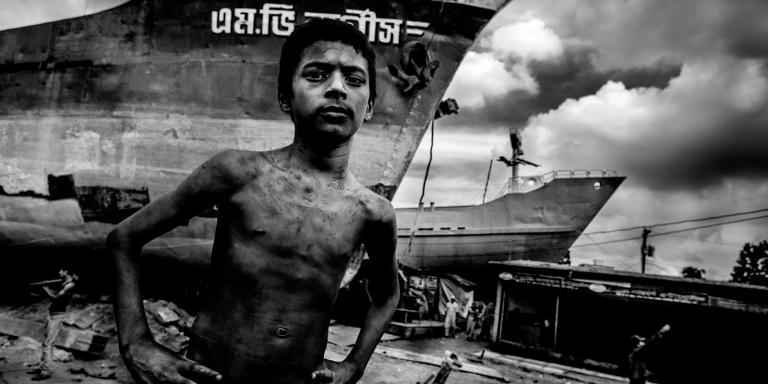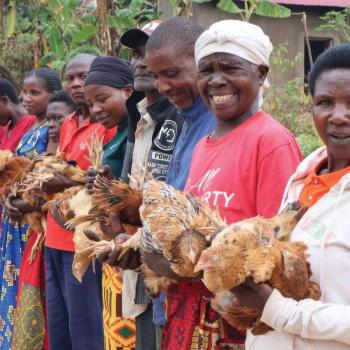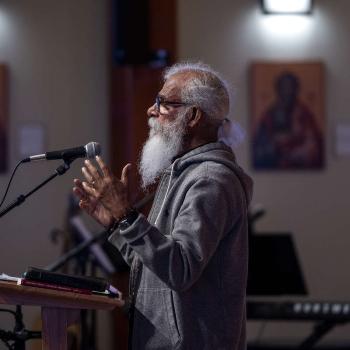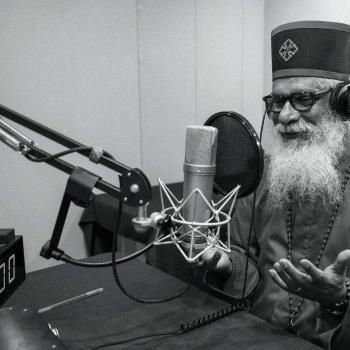WILLS POINT, TX – Gospel for Asia (GFA) issues a Special Report regarding child labor today: Millions of Children Trapped between Extreme Poverty and the Profits of Others
In a report written by Lee Tucker, a consultant to Human Rights Watch, about the problem of bonded labor in Asia, a young girl shared,
“My sister is 10 years old. Every morning at 7:00 she goes to the bonded-labor man, and every night at 9:00 she comes home. He treats her badly. He hits her if he thinks she is working slowly, or if she talks to the other children, he yells at her. He comes looking for her if she is sick and cannot go to work. I feel this is very difficult for her.
“I don’t care about school or playing. I don’t care about any of that. All I want is to bring my sister home from the bonded-labor man. For 600 rupees I can bring her home. That is our only chance to get her back.
“We don’t have 600 rupees … we will never have 600 rupees [the equivalent of U.S. $17 at the time of writing].”
Global Overview of Child Labor Today
These girls’ story is heart-breaking.
It is unthinkable that a child would be subject to such mistreatment.
It is deplorable that stories like this are all too common among the most poverty-stricken portions of the world.
It is beyond despicable that an estimated 218 million children as young as 5 years old are employed, and that at least 152 million are in forced child labor, according to basic facts about child labor published by the Child labor Coalition.
The facts also reveal several other startling realities about child labor. Among them:
- Children under the age of 12 perform up to a fourth of all hazardous child labor.
- Almost half of all forced child laborers are between the ages of 5 and 11.
- More than 134 million children in forced labor are in Africa and the region of Asia and the Pacific.
If the 218 million child laborers constituted a country of their own, it would be the fifth largest country in the world, exceeded in population only by China, India, the United States and Indonesia.
Top ten worst countries for child labor
as listed by the Maplecroft Child labor Index4
1
BANGLADESH
garment factories, farming, manufacturing
2
CHAD
agriculture, military
3
THE DEMOCRATIC REPUBLIC OF THE CONGO
mining, agriculture, industry, military
4
ETHIOPIA
mining, vending, shoe shining
5
INDIA
mining, agriculture, garment factories
6
LIBERIA
hazardous farming conditions
7
MYANMAR
agriculture, construction, small-scale industry
8
NIGERIA
agriculture, street begging, mining, construction
9
PAKISTAN
agriculture, garbage scavenging, carpet weaving, coal mining, brick kilns
10
SOMALIA
fishing, threshing, construction, hawking, begging
The International Labor Organization (ILO) maintains a limited list of National Child labor Survey Reports, Baseline Survey Reports, Rapid Assessment Reports and Micro-Data Sets for a variety of countries taken over the past 20 years—some as recent as 2018.
Although some participation in child labor can be quantified—such as in Nigeria where more than 15 million children are estimated to be child laborers—one of the overriding problems with looking at the issue from a global or even a national level is that it is generally agreed “that census data is likely to underestimate the scale of child labor.”
In areas where national regulations mandate education for children within certain age ranges, the threat of legal consequences likely deters complete reporting of child labor. Census data typically only includes children living within a family household. Children who are orphaned, or living on the streets may go undetected, even when it is those children who may be in greatest danger of child labor. It is, therefore, expected that the occurrence of child labor is higher than reports reveal.
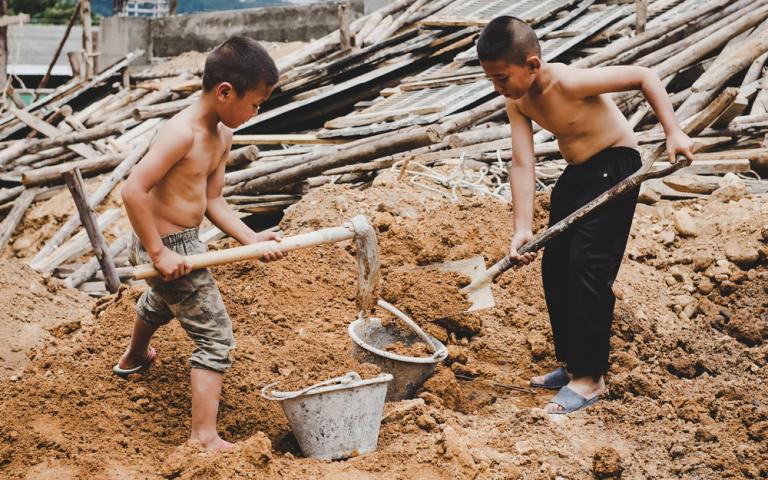
What Is a Good Definition of Child Labor?
It is important to recognize the prevalence of child labor in order to gain a realistic perspective on how pervasive it is. We need to understand the generally accepted definitions of child labor. Only then can we comprehend the often-irreparable physical and emotional damage inflicted on children, both presently and in their future.
Some child labor is innocuous and, in fact, may generally be regarded as positive. The International Labor Organization recognizes that activities such as doing chores around the home, “assisting in a family business or earning pocket money outside school hours and during school holidays” can “contribute to children’s development and… provide them with skills and experience… that prepare them to be productive members of society during their adult life.” Therefore, these activities are not officially considered to be child labor.
The ILO further defines child labor as “work that deprives children of their childhood, their potential and their dignity, and that is harmful to physical and mental development.”
International law divides child labor into three categories:
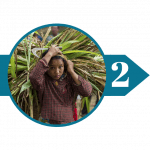 “Labor performed by a child who is under the minimum age specified for that kind of work (as defined by national legislation, in accordance with accepted international standards), and that is thus likely to impede the child’s education and full development.
“Labor performed by a child who is under the minimum age specified for that kind of work (as defined by national legislation, in accordance with accepted international standards), and that is thus likely to impede the child’s education and full development.
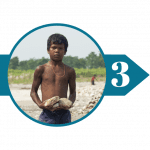 “Labor that jeopardizes the physical, mental or moral well-being of a child, either because of its nature or because of the conditions in which it is carried out, known as ‘hazardous work.’ ”
“Labor that jeopardizes the physical, mental or moral well-being of a child, either because of its nature or because of the conditions in which it is carried out, known as ‘hazardous work.’ ”
Notwithstanding a few reasonable exceptions, the ILO Convention Concerning Minimum Age for Admission to Employment (C138) adopted in 1973 states that:
“Each Member which ratifies this Convention shall specify…a minimum age for admission to employment or work within its territory [that] no one under that age shall be admitted to employment or work in any occupation. …The minimum age specified…shall not be less than the age of completion of compulsory schooling and, in any case, shall not be less than 15 years.”
Similarly, ILO Convention 182 adopted in 2000 defines the worst forms of child labor as:
- “All forms of slavery or practices similar to slavery, such as the sale or trafficking of children, debt bondage and serfdom, or forced or compulsory labor, including forced or compulsory recruitment of children for use in armed conflict;
- “the use, procuring, or offering of a child for prostitution, for the production of pornography or for pornographic performances;
- “the use, procuring or offering of a child for illicit activities, in particular, for the production and trafficking of drugs …;
- “work which, by its nature or the circumstances in which it is carried out, is likely to harm the health, safety or morals of children.”
Finally, forced labor is defined by ILO Convention 29 adopted in 1930 as “all work or service exacted from any person under the menace of any penalty and for which the said person has not offered himself voluntarily.”
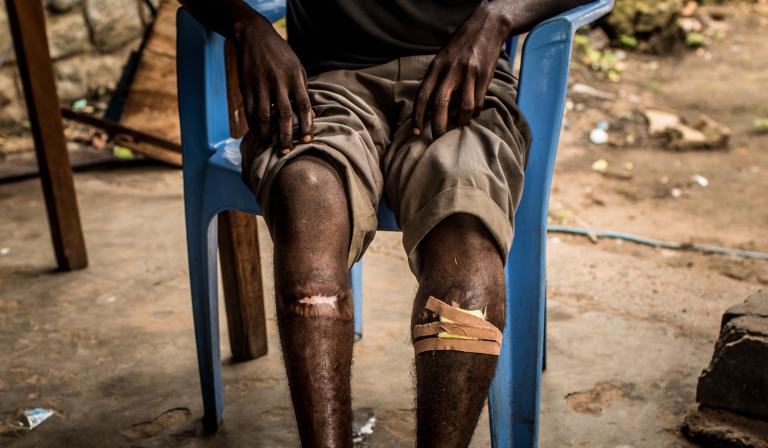
Harmful Effects of Child Labor
Childhood is an essential, formative time of life—one which many child laborers must leave too quickly. Their lives may long bear the physical, emotional and physiological consequences of their early adulthood. Many child laborers, regardless of whether they are considered forced or not, lack the chance of acquiring the knowledge and skills necessary to extract themselves from the poverty they were born or thrust into by circumstances. Many enter adulthood with no means of securing a better life and with few options for jobs, which extends the continuum of generational poverty to their own children.
Child laborers are highly susceptible to become involved in dangerous situations that may result in their illness, injury or even death.
In an article by Voice of America concerning child labor, ILO Director-General, Guy Ryder, said, “Honestly, the annual toll is appalling—2.78 million work-related deaths, 374 million injuries and illnesses. If these were the victims of a war, we would be talking a lot about it. Children and young workers are at greater risk and suffer disproportionately and with longer lasting consequences.”
A World Bank report estimated that 10 percent of all work-related injuries child laborers experience are crushing accidents, amputations and fractures.
Annual Toll of Child Labor:
2.78
million
work related deaths
374
million
injuries and illnesses
Mired in Mining
An article in Fortune magazine told how 15-year-old Lukasa rises at 5 a.m. to begin his 12-hour workday. He leaves his family’s mud-brick home in a tiny village in the southern region of the DRC, and he walks two hours to a government-owned mining site. He spends the next eight hours hacking away at rock in a cobalt mine.
He typically hoists a sack of as much as 22 pounds of cobalt up and out of the pit, then carries it on his back for an hour to a trading depot where he sells it to one of the Chinese trading companies who dominate the market in the area.
On a good day, the teenager can earn as much as $9 before making the long walk home.
Cobalt is key to the DRC’s economy—it produces an estimated 65 percent of the world’s cobalt supply—but child labor is rampant in its mining industry. The same Fortune story said, “While it is impossible to know how many underage miners there are, Congolese activists working to end child labor say… there are about 10,000 of them.
A National Bureau of Economic Research on child labor found that “most child labor occurs in countries with extremely low per capita GDP and that per capita GDP (and its square) explains 80 percent of the worldwide cross-country variation in child labor.” The GDP per capita for the DRC was $439 in 2017, in contrast to the GDP per capita for the USA in 2017, which was $59,531.
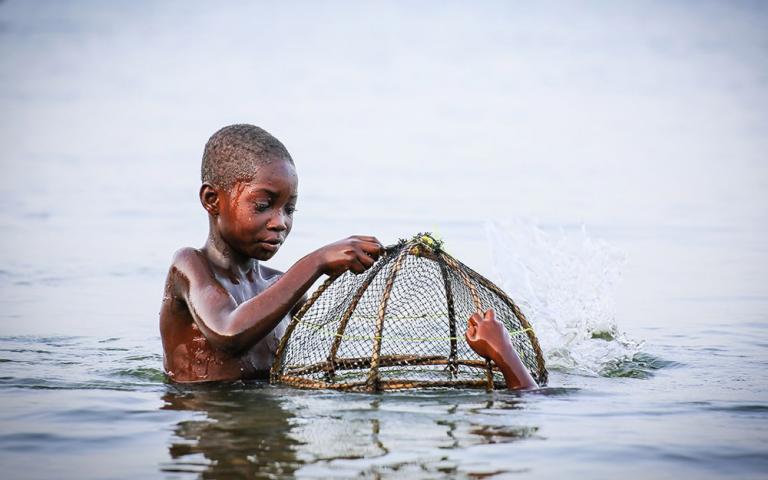
Enslaved in Fishing
“Workers at sea are among the world’s most vulnerable,” according to the U.S. Department of Labor. Various factors, such as working in international waters, produce gaps in applicable laws leaving workers without adequate labor protections in countries like Honduras, Philippines, Bangladesh, Ghana, Haiti, Cambodia, Indonesia and Thailand.
James Kofi Annan lives in Ghana. His story is typical of child laborers trapped in the commercial fishing industry.
“I started my working life early. My parents had 12 children, none of whom were educated. By the time I was six years old, I was the only person my father could control. All the others were older and most of them had already been given away to work. As the youngest, I was the only one still available. My father saw the opportunity and gave me away for fishing work. The way it works is that the person who takes charge of you now has control over you.
I was first trafficked with five other children. Out of the six of us, three lived, and three did not. I saw many children die from either abuse or the rigorous work they were obliged to do.
There, I was forced to work excruciating hours catching fish on Lake Volta. On a daily basis, my day started at 3 a.m. and ended at 8 p.m. It was full of physically demanding work. I was usually fed once a day and would regularly contract painful diseases which were never treated as I was denied access to medical care. If I asked for even the smallest concession from my boss, I was beaten. Despite all my hard work, I was often not allowed to sleep because I had to take care of all the other tasks, such as mending nets and cleaning fish.”
It took James seven years to escape his slavery.
Surrounded by Tobacco
Investigations by Human Rights Watch found consistent, significant risks to children’s health and safety who are working on tobacco farms in Zimbabwe, the United States and Indonesia. The children are exposed to nicotine and toxic pesticides. Every child interviewed described having illnesses with specific symptoms associated with acute nicotine poisoning and pesticide exposure, including nausea, vomiting, loss of appetite, headaches, dizziness, irritation and difficulty breathing.
Ironically, it is still legal in the United States for children as young as 12 to work on tobacco farms, as long as they have parental permission. There are no age limitations for children who work on small, family-owned farms.
A 2018 special series on NPR’s “Here & Now” reported finding children as young as 7 working during the picking season in North Carolina where tobacco farming is regarded as a legacy.
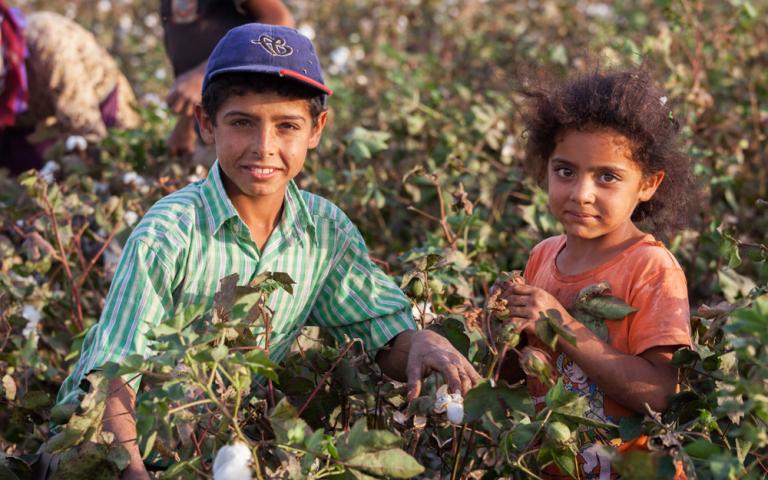
Hemmed In by Cotton, Clothing and Chocolate
Cotton is the best-selling fiber in the world, making the cotton market very appealing.
But according to a New Lanark article, “Children & Cotton”, child laborers in cotton fields and factories may work for up to 12 hours a day, seven days a week during the harvest period for less than $1.50 a day. The article further states, “Without the child workers, the landowners wouldn’t manage to harvest all of their crops.” In some countries, including Uzbekistan, Tajikistan, Kyrgyzstan and China, child labor in cotton fields is actually sanctioned by the government.
Sewing blue jeans may not seem like a burdensome task, but it becomes one when her production quota is 60 pockets per hour, every hour, every day she works. That’s 480 pockets over an eight-hour shift. For this, she earns the equivalent of about $1.00 a day.
The Food Empowerment Project investigated the cocoa industry, where the supply chain for major chocolate manufacturers begins. Their findings read:
“On average, cocoa farmers earn less than $2 per day, an income below the poverty line. As a result, they often resort to the use of child labor to keep their prices competitive. … Often, traffickers abduct the young children from small villages in neighboring African countries, such as Burkina Faso and Mali, two of the poorest countries in the world. Once they have been taken to the cocoa farms, the children may not see their families for years, if ever. … Some of the children use chainsaws to clear the forests. Other children climb the cocoa trees to cut bean pods using a machete. …
“The farm owners using child labor usually provide the children with the cheapest food available, such as corn paste and bananas. In some cases, the children sleep on wooden planks in small windowless buildings with no access to clean water or sanitary bathrooms. … Former cocoa slave Aly Diabate told reporters, ’The beatings were a part of my life. I had seen others who tried to escape. When they tried, they were severely beaten.’”
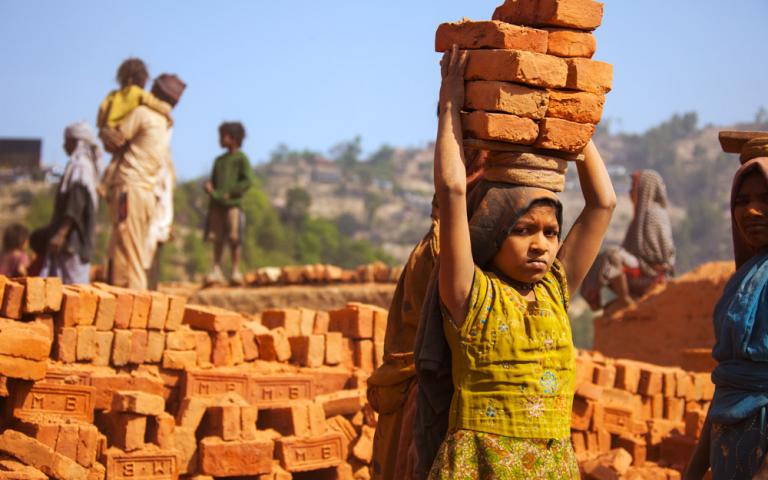
Burdened in Brick Kilns
A special report by Gospel for Asia (GFA) shared the results of an investigation into slave labor by the International Justice Mission (IJM). After IJM workers helped 260 people—including children forced into labor—escape from one brick factory, a father shared how he and his family were tricked into working there.
Instead of receiving the good salary they were promised, his trapped family worked 16 hours a day, seven days a week. Their employer denied them hospital visits for injuries sustained while mixing or forming the bricks. Children caught playing during work hours received a torrent of verbal abuse and beatings with a pipe.
According to an 86-page report by ILO, 56 percent of brick makers in Afghanistan are children.
One of those is 11-year-old Sima. She works 13 hours per day, six days a week. At the time of the report, she had already been working in brick kilns for five years. She has never attended school and is illiterate. Sima’s circumstances are typical of children laboring in brick kilns. Many begin working at the age of 5.
The report also explains the physical implication of “manual handling of heavy weights … long working hours with awkward posture [and] monotonous and repetitive work.” Child laborers in brick kilns have a high risk of developing health problems like as musculo-skeletal issues, poor bone development and early-onset arthritis.
The ILO further observed that “the cost of child bonded labor is paid over a lifetime through the loss of health, education, and opportunities.”
These are only a few of the industries in which child labor continues to exist.

Child Labor: Not Gone, but Forgotten: Part 2 | Part 3
Source: Gospel for Asia Special Report, Child Labor: Not Gone, but Forgotten
Learn more about the children who find themselves discarded, orphaned and abused, and the home and hope that they can be given through agencies like Gospel for Asia.
Click here, to read more blogs on Patheos from Gospel for Asia.
Learn more about Gospel for Asia: Facebook | YouTube | Instagram | Sourcewatch | Integrity | Lawsuit Update | 5 Distinctives | 6 Remarkable Facts | Media Room | Poverty Solutions | Endorsements | 40th Anniversary | Lawsuit Response


